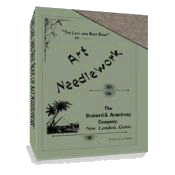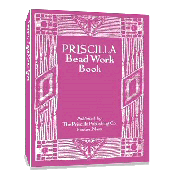Home-Made Holiday Gifts
1897 Style!
These home-made holiday gifts were suggested to ladies in 1897. Unfortunately, there are no pictures to go along with the projects but they are easy enough to understand and most will find it easy to visualize the end result.
Home Made Holiday Gifts
Harper's Bazaar, November, 1897.
Edited for use on this site
Holiday Gift #1
Engagement List Holder
Something new in the way of a panel for holding engagement-lists is made of plush and set in a frame. To make this decorative bit of fancy-work, take a piece of thick pasteboard half a yard in length and seven inches in width. Cover this with paper, old rose in color, on the wrong side, and the dark blue plush on the right side.
Next cut seven strips of thin card-board, and cover four of them with old-rose plush, and three with the dark blue plush. They should measure seven inches one way and an inch and a half the other. Fasten these on the plush panel, placing an old-rose one at the bottom, next a blue, and alternating in this way until the seven are used. One the top one should be pasted a little white slip bearing the word Monday, on the next should be Tuesday, and so for all the days of the week, the plush strips forming receptacles to hold the different lists of engagements for the week.
When these seven strips are on, there will still be a space above left on the plush panel. On this should be painted the word Engagements, in gold and large enough to stretch nearly across the panel, which should then be framed in very narrow gilded beading, which can be bought at a picture-store.
Home-Made Holiday Gift #2
A Handsome Tea Cozy #1
A handsome tea cozy is made of white satin. On each side is laid over the white satin a hand-painted piece of white bolding-cloth, the designs being of white bride-roses, buds and delicate green leaves. A white satin puff is set in around the entire top of the cozy, joining the two sides together. The lining is also of white satin.
My note: See Tea Cozy #3 for more information on making a tea cozy.
A Handsome Tea Cozy #2
Another quieter model is deep copper-colored satin damask embroidered in gold, the pattern being Oriental in style. A heavy cord of copper-color and gold holds the two sides together, three loops of the cord at the top being used to lift it with. The lining is of copper satin.
My note: See Tea Cozy #3 for more information on making a tea cozy.
A Handsome Tea Cozy #3
A third and simple cozy is one of light blue linen, the shade which comes in all the art materials, and directions to make this can be applied to doing either of the others.
Take two pieces of blue linen about fourteen inches across the base and about twelve inches high. This will make a good-sized cozy. Curve the pieces around the top. Cut the two pieces for the lining a trifle smaller, to allow for the interlining of cotton. The lining should be of the same blue linen; the cotton, two thicknesses of the ordinary white cotton which comes in rolls.
Baste the cotton on to the lining, having first stitched together the two pieces of lining. Next baste on the two outside pieces of linen, turning in the edges, and catching together invisibly. Finish with a thick white cord. To improve on this perfectly plain cozy, first embroider the two outside pieces of linen in clusters of blue ragged-sailors of different shades; make them stand up straight from the base as if growing. In this case a blue cord will be in better taste than a white with which to finish the edge.
Home-Made Holiday Gift #3
A Novel Wall Pocket
A novel wall-pocket is made by cutting from heavy pasteboard a shield-shaped piece, half a yard in length, and about twelve inches at the top in width, narrowing down toward the bottom. Paste a lining on the back of deep Empire-red paper; cover the front with velvet or fine quality velveteen of the same dark red; this is also done by pasting down the velvet edges.
Next make a pocket of silk, either plain red or fancy damask in colors that harmonize with the red. Cut the silk, allowing for fullness, turn in the top an inch and a half, and gather on a cord. Shape the sides and bottom to fit around the shield at the lower end, but keep the silk full all the way around, forming a puffy pocket by pasting the edges to the edges of the shield. This pocket should reach not quite half-way up the shield.
Finish the edge wall around the entire shield by a flat band of fancy silk and gold gimp, and fasten a piece of it diagonally across the upper part of the shield, as this is very effective in the way of chaste decoration.
Home-Made Holiday Gift #4
A Quaint Match Match Holder and Scratcher
A quaint conceit for matches is a piece of white card board eight inches wide and seven inches high. It is shaped after a Louis XVI design, and across it from left to right is painted a limb of a tree, with several smaller branches and scant foliage. A gay little cupid sits on a top branch playing on a violin, while somewhat below and to the right sit two lovers, hand in hand, he on his individual branch and she on hers, both quite sure where matches are made.
The prosaic part is the little pocket formed on the card-board tied on with tiny blue ribbon bows, in which are placed the matches to strike on the small square of sand-paper pasted below. This contrivance is hung up by a narrow blue ribbon.
Home-Made Holiday Gift #5
A Geranium Red Pen Wiper
A small novelty is a pen-wiper of the new shade of geranium-red cloth, on which is placed an entire egg-shell – the contents having been blown out through small holes – painted to represent a clown, with a huge ruffle of Nile green crepe paper encircling his neck. This is a very simple manufacture.
Home-Made Holiday Gift #6
For the Person Who Has Everything
(My note: I’m not sure why you would make this except that it definitely IS unique. Maybe I’m just not picturing it right in my mind! )
Another simple article is a bit of turquoise-blue cloth simulating the open sea, and resting on it is a diminutive egg-shell boat, contain a droll little chicken made of feathers, and grasping in his hand a feather oar.
Home-Made Holiday Gift #7
A Waist or Coat Hanger
A useful contrivance beautifies is the wooden form for hanging a dress waist or coat upon. This article can be bought at any of the shops at a very small outlay.
To cover it, cut from silk or linen or any other smooth material two pieces large enough to allow of a lining of cotton. Baste the latter in and stitch the two pieces of goods together, leaving room to slip over the form. Sew up this opening and tie around the centre of the form, close by the hook with which it is suspended in the closet, a satin ribbon with bow and ends.
Home-Made Holiday Gift #8
A Laundry Bag
Something original in the way of a useful bag to hold soiled clothing or pieces of dress goods and other craps, or, when smaller, convenient as a work-bag, is a receptacle made of white or colored pique or duck.
For the smaller size take two pieces of white pique twenty inches long, twelve inches wide. Baste on each a design in blue linen — a spray of flowers or a conventional pattern — and embroider it on it blue and white flosses.
Curve the two pieces in a deep circle at the bottom; at the top cut in rounded lobes, or square, if preferred; line these with blue satin or moiré ribbons. The squares should be about four inches when finished.
Return to top of Home-Made Holiday Gifts – 1897 Style.
Return to Victorian Christmas page.
The Last and Best Book of Art Needlework
Over 100 pages of authentic Victorian instructions and patterns from 1895!
FREE
Beeton's Book Of Needlework

433 pages!
Sign up for VEAC! Everything you wanted to know about Victorian embroidery, needlework, crafts and more!
Priscilla Bead Work Book
Make Beautiful Victorian Beaded Purses, Jewelry & Accessories - Starting
TODAY!



